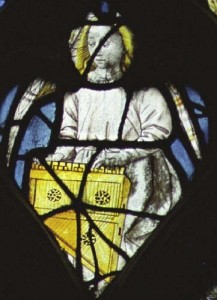The East Yorkshire port of Kingston upon Hull – though now gearing up to be UK City of Culture for 2017 – is probably not thought of as an avant-garde cultural centre in the medieval and early modern periods. It was bought from Meaux Abbey by Edward I for the specific purpose of establishing a royal port in east Yorkshire, and records of successive town governments show a strong focus on the business of managing trade into and out of the port rather than much interest in drama, music or anything else likely to attract the interest of REED editors.
However, a brief trawl through the helpful index of The Customs Accounts of Medieval Hull, ed. Wendy Childs[1], reveals that there was at least some interest in music and instruments – and rather fashionable ones at that. The Collectors’ Accounts for two years 1463 and 1483, show Hanse merchants importing into Hull not only lutes (two in one shipment in 1463, a dozen in one of 1483) and large quantities of lute-strings, but also on occasion other, perhaps less predictable, stringed instruments, shipped along with a variety of non-musical goods from cloth and wainscot to animal hides and eels. The shipment containing two lutes in 1463 also contained ‘1 par’ clavysymbelles’; two shipments arriving in July 1483 contained respectively ‘1 par’ clavysymballes’ and ‘4 par’ clavycordes’. (It’s not clear what the reference to ‘pairs’ indicates: it may simply mean a set, as virginals were also known as ‘pairs’ – denoting not a pair, in fact, but a single instrument.)
According to the New Grove Dictionary of Music, clavichords were hardly new in the second half of the fifteenth century:

Earliest surviving clavichord, by Domenico da Pesaro, 1543 (Musikinstrumenten-Museum, University of Leipzig): accompanying the article in Grove Music Online.
‘it is clear from both pictures and writings that clavichords not too unlike those that are known from surviving examples [see picture] were in existence in the early years of the 15th century.’[2]
Similarly, clavicymbals (an English translation of the Latin clavicymbalum), an early, smaller, version of the harpsichord, seem to have been in existence from before 1400:

Angel with clavicymbalum: 15C window in church of Notre-Dame, Caudebec-en-Caux, France. From http://www.apemutam.org/instrumentsmedievaux/pages/clavic.html (accessed 1.12.15).
‘The earliest known reference to a harpsichord dates from 1397, when a jurist in Padua wrote that a certain Hermann Poll claimed to have invented an instrument called the ‘clavicembalum’; and the earliest known representation of a harpsichord is a sculpture in an altarpiece of 1425 from Minden in north-west Germany.’[3]
What is of interest in these Hull records is: who, in Hull or the East Riding, might have been buying such instruments? We know that both Hull and Beverley regularly employed waits, and according to the later ordinances of the Beverley-based Minstrels’ Guild, the East Riding must have been well-supplied with musicians at that period. But as Richard Rastall has commented, waits and minstrels are unlikely to have been buying, or playing, this kind of instrument.[4] We have to look towards the magnates of the area, such as the De La Poles, ennobled Hull merchants who by the mid-fifteenth century were Earls of Suffolk; or of course the Percy Earls of Northumberland, who owned and regularly stayed in castles at Alnwick in Northumberland, Leconfield (close to Beverley) and Wressle (close to Howden in the far west of the East Riding). Whether surviving records will turn up evidence to identify the purchasers of the particular instruments recorded in the Hull Collectors’ accounts of 1463 and 1483 remains to be seen, but as REED-NE researches continue, watch this space!
NOTES:
[1] Wendy R Childs, ed., The Customs Accounts of Medieval Hull, 1453-1490. YAS RS CXLIV, 1986 for 1984.
[2] Grove Music Online: http://www.oxfordmusiconline.com.ezphost.dur.ac.uk/subscriber/article/grove/music/05909?q=clavichord&search=quick&source=omo_gmo&pos=1&_start=1#firsthit (accessed 1.12.15).
[3] Grove Music Online, entry for Harpsichord: http://www.oxfordmusiconline.com.ezphost.dur.ac.uk/subscriber/article/grove/music/12420#S12420 (accessed 1.12.15).
[4] ‘My memory is that some of the newly-wealthy merchant class started aping their betters in the early 16th century – or perhaps the very late 15th – by buying and playing stringed keyboards: but I’d say it was really only in royal and noble households that you’d normally find them until well into the 16th century.’ (Richard Rastall, personal email message.)
*This month’s Flower has been very kindly provided by the editor of the East Riding volume, Dr Diana Wyatt.

Flower of the month? – Harpischords? Clearly my botany isn’t what it used to be (or vice-versa)………